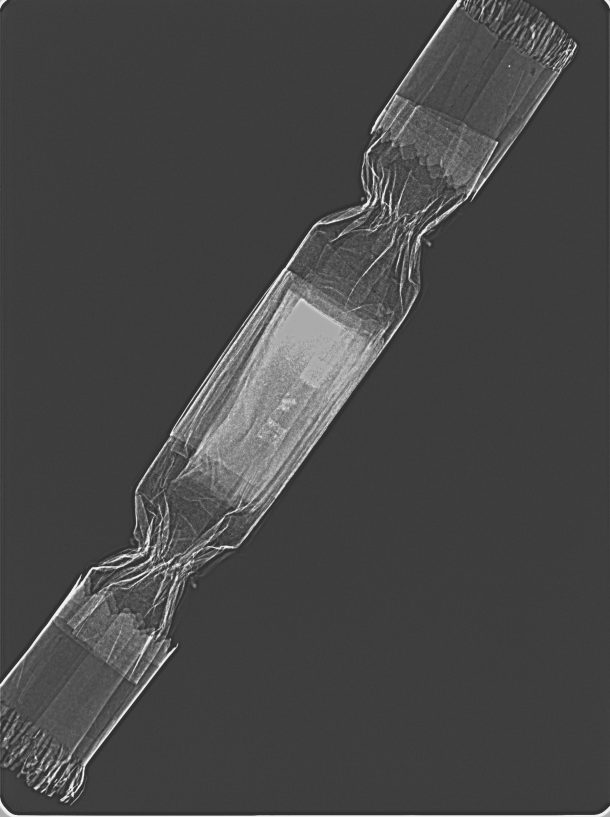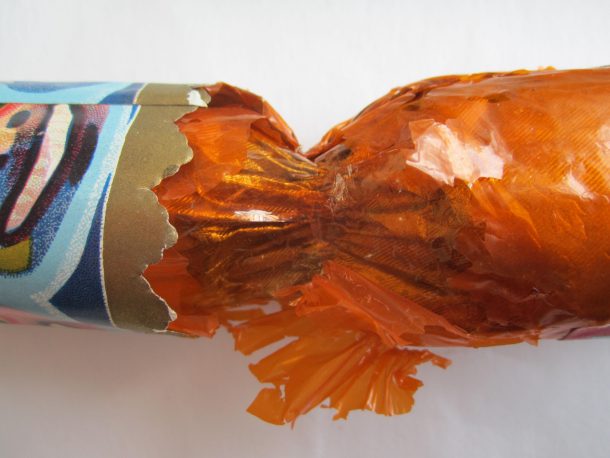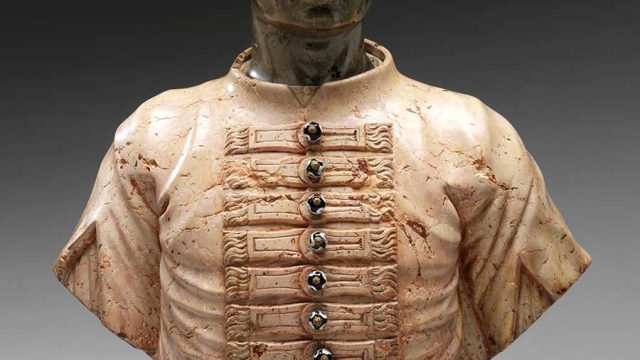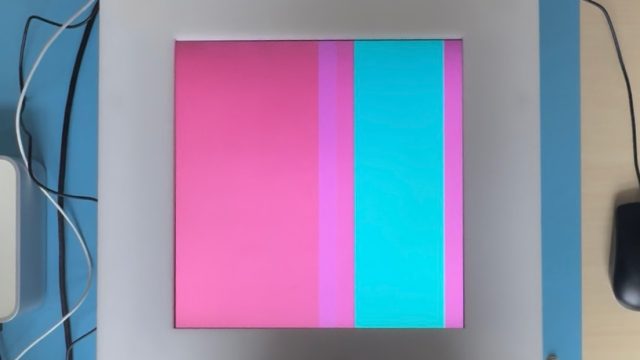by Alice Woodward, MA Student, University of Northumbria
Paper conservators usually work on flat works, but in some cases are presented with the challenges of conserving three-dimensional objects comprised of mixed materials. This article focuses on the conservation of a rather unusual three-dimensional object – a Christmas cracker from 1927 (S.26-2007), in preparation for a Christmas display in the Theatre and Performance Galleries at the Victoria and Albert Museum in 2016.
The Christmas cracker was invented in the late 1840s by Tom Smith.1 On a trip to Paris, Tom came across the bon-bon (sugared almonds wrapped in a twist of tissue paper), and incorporated it into his own product range of wedding cake decorations and confectionery at his grocery on London’s Goswell Road. A few years later, love mottos were placed inside the wrapping, followed by small toys and trinkets, to immediate success. In the 1850s, the product evolved fully into the Christmas cracker, when Tom heard the crackling of logs burning on an open fire and was inspired to invent the cracker ‘snap’.
Given the disposable nature of Christmas crackers, it was rather remarkable that this cracker (Figure 1) escaped being pulled open on Christmas Day, and arrived in the V&A’s collection with its snap still in intact. The cracker was one of the ‘Totem Crackers’ made by Tom Smith & Company and was illustrated with an image of a Totem-Pole girl from the hit musical ‘Rose Marie’, which opened in London at the Theatre Royal Drury Lane in March 1925 and ran there for 851 performances. According to ‘Tom Smith’s Christmas Crackers & Novelties’ catalogue from 1927-8, the cracker came from a box of twelve (four crimson, four green and four golden), which contained totem head-dresses, musical toys, imitation jewellery, ‘curios’ and the usual jokes. The contents of the cracker can be seen in the X-ray shown in Figure 2, but it is difficult to infer which one the hidden gift may be.


The cracker is constructed in several layers. A layer of golden embossed paper covers the internal card tube, and the outermost layer is a transparent orange film. An image of the head and shoulders of a Totem-Pole girl is adhered to the center, and each end of the cracker has a paper border (printed with patterns inspired by those on the Totem-Pole girls’ costumes) with gold-fringed ends.
In terms of condition, the ends of the cracker were crumpled and the rubber band was cutting into the orange film. Most alarmingly, the orange film was severely degraded and torn, requiring the addition of a support material to prevent the loose flaps from detaching. Initial treatment involved the removal of the rubber band and the ends of the cracker were reshaped. Melinex loops were inserted to support the fringed edges.
On initial examination the orange film was identified as cellophane, however in the 1927-28 Tom Smith catalogue it was described as orange gelatine. An article in the December 1891 edition of ‘The Strand Magazine’ includes a detailed description of how Tom Smith’s crackers were manufactured and most interestingly how the gelatine film was made, by poring dyed molten gelatine onto a sheet of glass.2 Small loose fragments of the orange film were analysed using Fourier transform infrared (FTIR) spectroscopy by the V&A Science Section, confirming that the orange material is indeed gelatine.
Since coloured gelatine film is a relatively unusual material, research on the conservation of cellophane was consulted to help with the selection of an appropriate support material. In a study by Léculier, Melinex was used to support torn cellophane in a collection of 21st century Vietnamese lanterns.3 However, due to the age and delicate nature of the gelatine film, adhering it to a strong film like Melinex could put the film at risk of more splitting if the object were subjected to changing environmental conditions. In addition, Melinex cannot be coloured so the repairs would be conspicuous.
Next began the search for a repair material that could be coloured. Isinglass (a protein-based glue derived from the swim bladder of the sturgeon fish) was considered initially, as it is known to have good aging properties. Isinglass was coloured with Cartasol K dyes before being cast into a film, but the dried film was very moisture sensitive and difficult to handle. Other potential materials were discussed with Elizabeth-Anne Haldane, from V&A Textile Conservation. Elizabeth-Anne suggested experimenting with Visking Dialysis Membrane, a material she was considering for the repair of a 1950s Balenciaga headpiece with ‘leaves’ made from cellophane attached to a ramie core.4 Visking is a transparent semi-permeable membrane used for filtration in medical applications. It is made of regenerated cellulose (from cotton linters) and comes in a range of thicknesses.5 Visking behaved in a similar way to the gelatine film when spot-tested with water, which resulted in moderate distortion and no change in gloss. In addition, Visking becomes flaccid and gel-like when immersed in water, so it could be coloured by immersion in a solution of Cartasol K dye. Dyed and undyed samples of Visking were sent for Oddy testing, to ascertain its suitability for conservation.
Due to time constraints, reversible repairs were carried out using Visking prior to receiving the test results. Visking was rinsed in water for three hours before being immersed in a solution of orange/red Cartasol K dyes (three drops orange + two drops red, in 100 ml deionised water) for 15 minutes, to produce a shade of orange that was slightly duller and paler than the original gelatine film. After air-drying, the Visking was cut into small pieces shaped to fit the areas requiring support. Each piece was threaded under the degraded gelatine film with tweezers (Figure 3), before the loose flaps of gelatine film were attached to the Visking with dots of adhesive, to allow for movement of the gelatine film. A 1:1 mixture of Lascaux 303 HV and Lascaux 498 HV was used, to ensure flexibility as well as good adhesion. Lascaux is suitable for non-absorbent supports and can be solubilised in alcohol, making it easy to reverse without causing distortion of the Visking and gelatine film. Finally, two grey/black twisted cotton threads were added to complete treatment and restore the aesthetical symmetry of the object (Figure 4).


The treatment was considered to be very successful as the loose flaps of gelatine film were secured and supported, and the adhesive was not visible. The losses were well disguised, as the gloss of the dyed Visking closely matched the gelatine film, and the colour was pale enough that any overlaps were discrete. It is likely that both materials will respond in a similar way when exposed to environmental changes, but further investigation is needed.
After treatment, the results of Oddy testing revealed that Visking is only appropriate for temporary use. However, the cracker has been monitored regularly over the past year and there have been no observable changes to either the Visking or gelatine. If any changes are detected in the future the Visking repair will be removed. Since the treatment of the cracker, ongoing testing has shown that there is potential for Visking to be used if it is treated before use, to remove the glycerine humectant and residual trace impurities from manufacture.4 It is hoped that this article raises awareness of the need for more research into the conservation of cellophane and gelatine films, and that Visking could be introduced as a new material for conservation after further testing and research.
Acknowledgements
I am extremely grateful to my supervisor, Susan Catcher, for her invaluable support throughout this project and to Elizabeth-Anne Haldane for introducing me to Visking Dialysis Membrane and advising on treatment options. I would also like to thank National Museums Scotland and Dr. Paul Garside (British Library) for Oddy testing.
References
- Kimpton, P., Tom Smith’s Christmas Crackers: An Illustrated History (Tempus, Stroud, 2004), pp. 14-27.
- ‘Christmas Crackers’, The Strand Magazine (December 1891), vol. 2, pp. 616-622. Available at: https://archive.org/stream/StrandMagazine12/Strand12#page/n65/mode/2up
- Léculier, A., Cellophane in Collections. Objects Specialty Group Postprints, vol. 10, 2003 (The American Institute for Conservation of Historic and Artistic Works, Washington, DC, United States, 2004), pp. 206-214. Available at: http://resources.conservation-us.org/wp-content/uploads/sites/8/2015/02/osg010-19.pdf
- Haldane, E.A., ‘Shiny Surfaces: the conservation of cellophane and related materials’, Preprints of the North American Textile Conservation Conference (6-11 November 2017), pp. 139-150.
- Visking Dialysis Tubing was purchased from Medicell Membranes Ltd. http://www.visking.com. Visking with a Molecular Weight Cut-off of 12-14000 Daltons (Size 9: pore size 24 Angstrom, thickness 0.03mm) was used, as the thickness matched the original gelatine film most closely.


